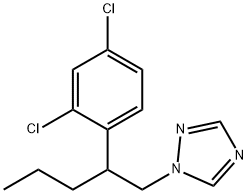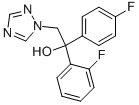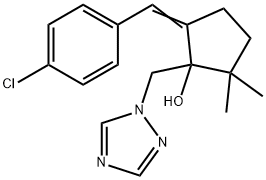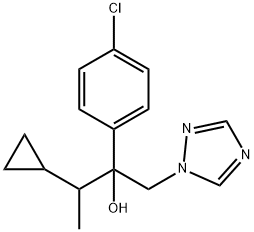Penconazole
- CAS NO.:66246-88-6
- Empirical Formula: C13H15Cl2N3
- Molecular Weight: 284.18
- MDL number: MFCD00078737
- EINECS: 266-275-6
- SAFETY DATA SHEET (SDS)
- Update Date: 2024-12-18 14:07:02

What is Penconazole?
The Uses of Penconazole
Penconazole is an conazole based fungicide that works by inhibiting cell membrane ergosterol biosynthesis, thus stopping the development of fungi.
The Uses of Penconazole
Penconazole is used for the control of powdery mildew, pome fruit scab and other pathogenic Ascomycetes, Basidiomycetes and Deuteromycetes on vines, cucurbits, pome fruit, stone fruit, ornamentals, hops, tobacco and vegetables.
Definition
ChEBI: 1-[2-(2,4-dichlorophenyl)pentyl]1,2,4-triazole is a member of the classof triazoles that is 1,2,4-triazole substituted at position 1 by a 2-(2,4-dichlorophenyl)pentyl group. It is a dichlorobenzene and a member of triazoles.
Agricultural Uses
Fungicide: Penconazole is a systemic fungicide used to control powdery mildew. It is used on apples and grapes and other fruits, hops, tobacco, ornamentals and on vegetables. Not currently registered in the U.S. Reported to be used in most European countries. Currently, there are more than 30 global suppliers.
Trade name
AWARD®; CGA-71818®; ONMEX®; TOPAS®; TOPAS-C®; TOPAS-MZ®; TOPAZ®; TOPAZE®; TOPAZE-C®; TOPENCO 100EC®
Safety Profile
Moderately toxic by ingestion and skin contact. When heated to decomposition it emits toxic vapors of NOx and Clí.
Metabolic pathway
Penconazole is metabolised in plants by hydroxylation of the propyl side chain and conjugation or metabolism to triazolylalanine and triazolylacetic acid. It is quite persistent in soils but degradation by sunlight requires only a few days. It is eliminated rapidly from mammals.
Degradation
Penconazole (1) is stable to hydrolysis at pH 1-13 and at temperatures up
to 350 °C. It is degraded in sunlight with a DT50 of 4 days in natural sunlight.
Its photochemical reactions have been studied. On irradiation with
light of wavelengths greater than 280 nm (high-pressure mercury lamp
with filter), the major reaction was the formation of a cyclised product (2)
(Scheme 1). Irradiation under the same conditions in isopropanol gave
mainly 2 and 3 (a dechlorinated product). After 8 hours, yields were 29.8%
of 2 and 12.3% of 3 respectively. The product 3 alone photodegraded
only slowly but 2 was completely photolysed within 3 hours to further
products, indicating its role as an intermediate in the photolytic pathways
(Schwack and Hartmann, 1992, 1994). In the presence of isopropanol,
photodehalogenation of 3 to 4 competed with substitution of a
solvent molecule to give a low yield (
Properties of Penconazole
| Melting point: | 58.5 °C |
| Boiling point: | 436.06°C (rough estimate) |
| Density | 1.2556 (rough estimate) |
| vapor pressure | 3.7 x l0-4 Pa (25 °C) |
| refractive index | 1.6300 (estimate) |
| Flash point: | 100 °C |
| storage temp. | 0-6°C |
| solubility | DMSO: 100 mg/mL (351.89 mM) |
| pka | 2.80±0.10(Predicted) |
| form | Solid |
| form | neat |
| Water Solubility | 73 mg l-1 (25 °C) |
| color | White |
| BRN | 541488 |
| CAS DataBase Reference | 66246-88-6(CAS DataBase Reference) |
| EPA Substance Registry System | Penconazole (66246-88-6) |
Safety information for Penconazole
| Signal word | Warning |
| Pictogram(s) |
 Exclamation Mark Irritant GHS07  Health Hazard GHS08  Environment GHS09 |
| GHS Hazard Statements |
H302:Acute toxicity,oral H410:Hazardous to the aquatic environment, long-term hazard |
| Precautionary Statement Codes |
P201:Obtain special instructions before use. P264:Wash hands thoroughly after handling. P264:Wash skin thouroughly after handling. P273:Avoid release to the environment. P280:Wear protective gloves/protective clothing/eye protection/face protection. P391:Collect spillage. Hazardous to the aquatic environment P308+P313:IF exposed or concerned: Get medical advice/attention. |
Computed Descriptors for Penconazole
New Products
(S)-3-Aminobutanenitrile hydrochloride 4-Methylphenylacetic acid N-Boc-D-alaninol N-BOC-D/L-ALANINOL Tert-butyl bis(2-chloroethyl)carbamate 3-Morpholino-1-(4-nitrophenyl)-5,6-dihydropyridin- 2(1H)-one Furan-2,5-Dicarboxylic Acid Tropic acid 1-Bromo-3,5-Di-Tert-Butylbenzene S-2-CHLORO PROPIONIC ACID ETHYL ISOCYANOACETATE 2-Bromo-1,3-Bis(Dimethylamino)Trimethinium Hexafluorophosphate 4-IODO BENZOIC ACID 3-NITRO-2-METHYL ANILINE 1-(2,4-DICHLOROPHENYL) ETHANAMINE (2-Hydroxyphenyl)acetonitrile 4-Bromopyrazole 2-(Cyanocyclohexyl)acetic acid 4-methoxy-3,5-dinitropyridine 1-(4-(aminomethyl)benzyl)urea hydrochloride 2-aminopropyl benzoate hydrochloride diethyl 2-(2-((tertbutoxycarbonyl)amino) ethyl)malonate tert-butyl 4- (ureidomethyl)benzylcarbamate Ethyl-2-chloro((4-methoxyphenyl)hydrazono)acetateRelated products of tetrahydrofuran








You may like
-
 Penconazole 98% (HPLC) CAS 66246-88-6View Details
Penconazole 98% (HPLC) CAS 66246-88-6View Details
66246-88-6 -
 Penconazol CAS 66246-88-6View Details
Penconazol CAS 66246-88-6View Details
66246-88-6 -
 Penconazol CAS 66246-88-6View Details
Penconazol CAS 66246-88-6View Details
66246-88-6 -
 1975-50-4 98%View Details
1975-50-4 98%View Details
1975-50-4 -
 2-HYDROXY BENZYL ALCOHOL 98%View Details
2-HYDROXY BENZYL ALCOHOL 98%View Details
90-01-7 -
 2-Chloro-1,3-Bis(Dimethylamino)Trimethinium Hexafluorophosphate 221615-75-4 98%View Details
2-Chloro-1,3-Bis(Dimethylamino)Trimethinium Hexafluorophosphate 221615-75-4 98%View Details
221615-75-4 -
 14714-50-2 (2-Hydroxyphenyl)acetonitrile 98+View Details
14714-50-2 (2-Hydroxyphenyl)acetonitrile 98+View Details
14714-50-2 -
 118753-70-1 98+View Details
118753-70-1 98+View Details
118753-70-1